SITXFSA001 Assessment: Food Safety and Hygiene Practices Explained
VerifiedAdded on 2022/08/15
|11
|3143
|38
Homework Assignment
AI Summary
This document is a completed assignment for the SITXFSA001 unit, focusing on hygienic practices for food safety. It addresses various aspects of food safety, including definitions of key terms like contaminants and contamination, legal requirements according to Food Safety Standard 3.2.2, and the importance of food safety programs. The assignment delves into the responsibilities of employees and employers, the role of local government regulators and Environmental Health Officers (EHOs), and the ramifications of failing to observe food safety laws. It provides examples of how health issues can pose hygiene risks, explains food poisoning causes, and details potential risks associated with improper food safety practices in different areas like fruits, vegetables, temperature control, cross-contamination, pests, and cleaning procedures. The assignment also lists essential hygiene actions, personal hygiene requirements, handwashing procedures, and the purpose of the Hazard Analysis of Critical Control Points (HACCP) system. Furthermore, it explores contamination methods, cross-contamination causes, and safety measures for handling eggs, aiming to provide a comprehensive understanding of food safety practices in the hospitality industry.
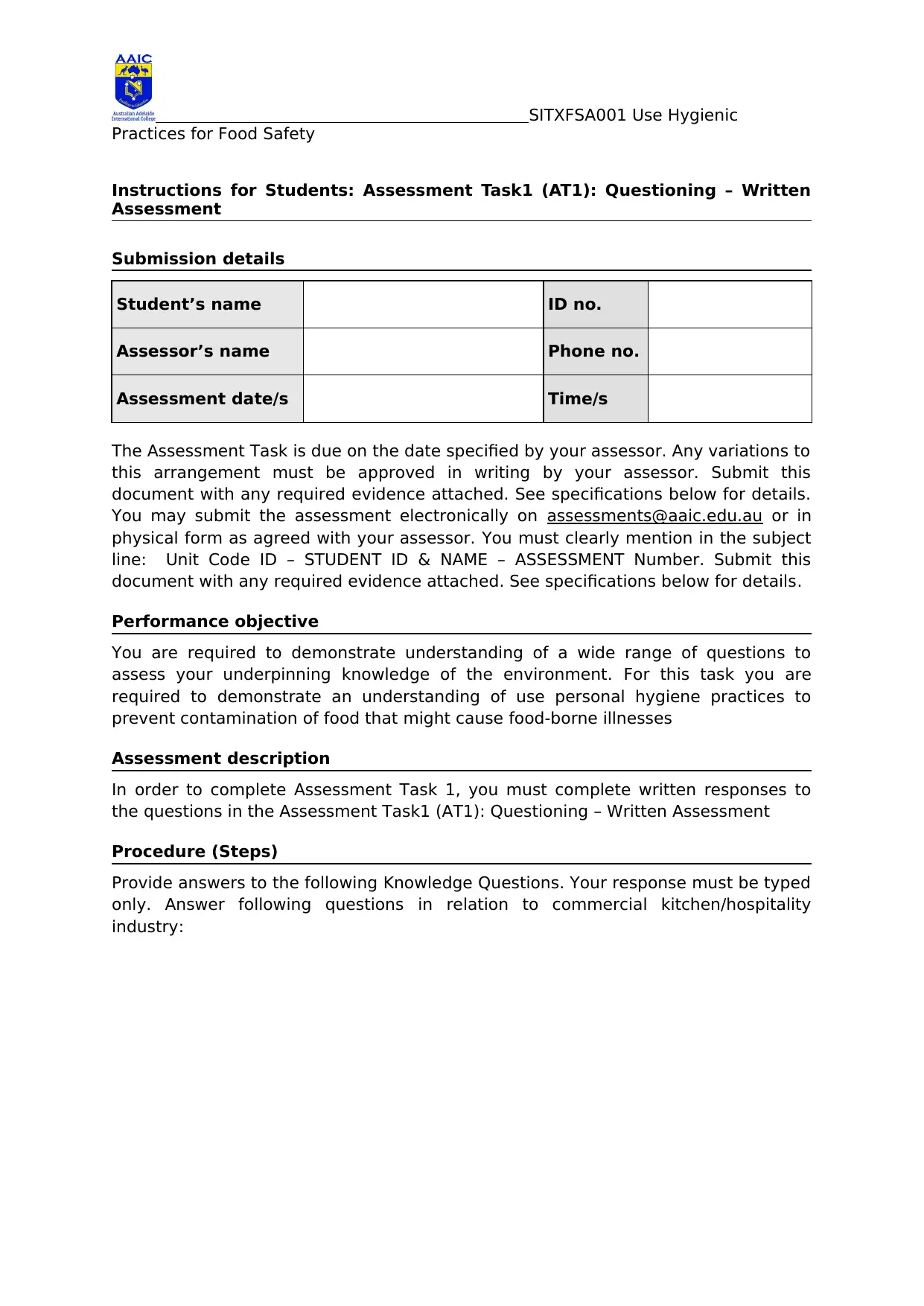
SITXFSA001 Use Hygienic
Practices for Food Safety
Instructions for Students: Assessment Task1 (AT1): Questioning – Written
Assessment
Submission details
Student’s name ID no.
Assessor’s name Phone no.
Assessment date/s Time/s
The Assessment Task is due on the date specified by your assessor. Any variations to
this arrangement must be approved in writing by your assessor. Submit this
document with any required evidence attached. See specifications below for details.
You may submit the assessment electronically on assessments@aaic.edu.au or in
physical form as agreed with your assessor. You must clearly mention in the subject
line: Unit Code ID – STUDENT ID & NAME – ASSESSMENT Number. Submit this
document with any required evidence attached. See specifications below for details.
Performance objective
You are required to demonstrate understanding of a wide range of questions to
assess your underpinning knowledge of the environment. For this task you are
required to demonstrate an understanding of use personal hygiene practices to
prevent contamination of food that might cause food-borne illnesses
Assessment description
In order to complete Assessment Task 1, you must complete written responses to
the questions in the Assessment Task1 (AT1): Questioning – Written Assessment
Procedure (Steps)
Provide answers to the following Knowledge Questions. Your response must be typed
only. Answer following questions in relation to commercial kitchen/hospitality
industry:
Practices for Food Safety
Instructions for Students: Assessment Task1 (AT1): Questioning – Written
Assessment
Submission details
Student’s name ID no.
Assessor’s name Phone no.
Assessment date/s Time/s
The Assessment Task is due on the date specified by your assessor. Any variations to
this arrangement must be approved in writing by your assessor. Submit this
document with any required evidence attached. See specifications below for details.
You may submit the assessment electronically on assessments@aaic.edu.au or in
physical form as agreed with your assessor. You must clearly mention in the subject
line: Unit Code ID – STUDENT ID & NAME – ASSESSMENT Number. Submit this
document with any required evidence attached. See specifications below for details.
Performance objective
You are required to demonstrate understanding of a wide range of questions to
assess your underpinning knowledge of the environment. For this task you are
required to demonstrate an understanding of use personal hygiene practices to
prevent contamination of food that might cause food-borne illnesses
Assessment description
In order to complete Assessment Task 1, you must complete written responses to
the questions in the Assessment Task1 (AT1): Questioning – Written Assessment
Procedure (Steps)
Provide answers to the following Knowledge Questions. Your response must be typed
only. Answer following questions in relation to commercial kitchen/hospitality
industry:
Paraphrase This Document
Need a fresh take? Get an instant paraphrase of this document with our AI Paraphraser
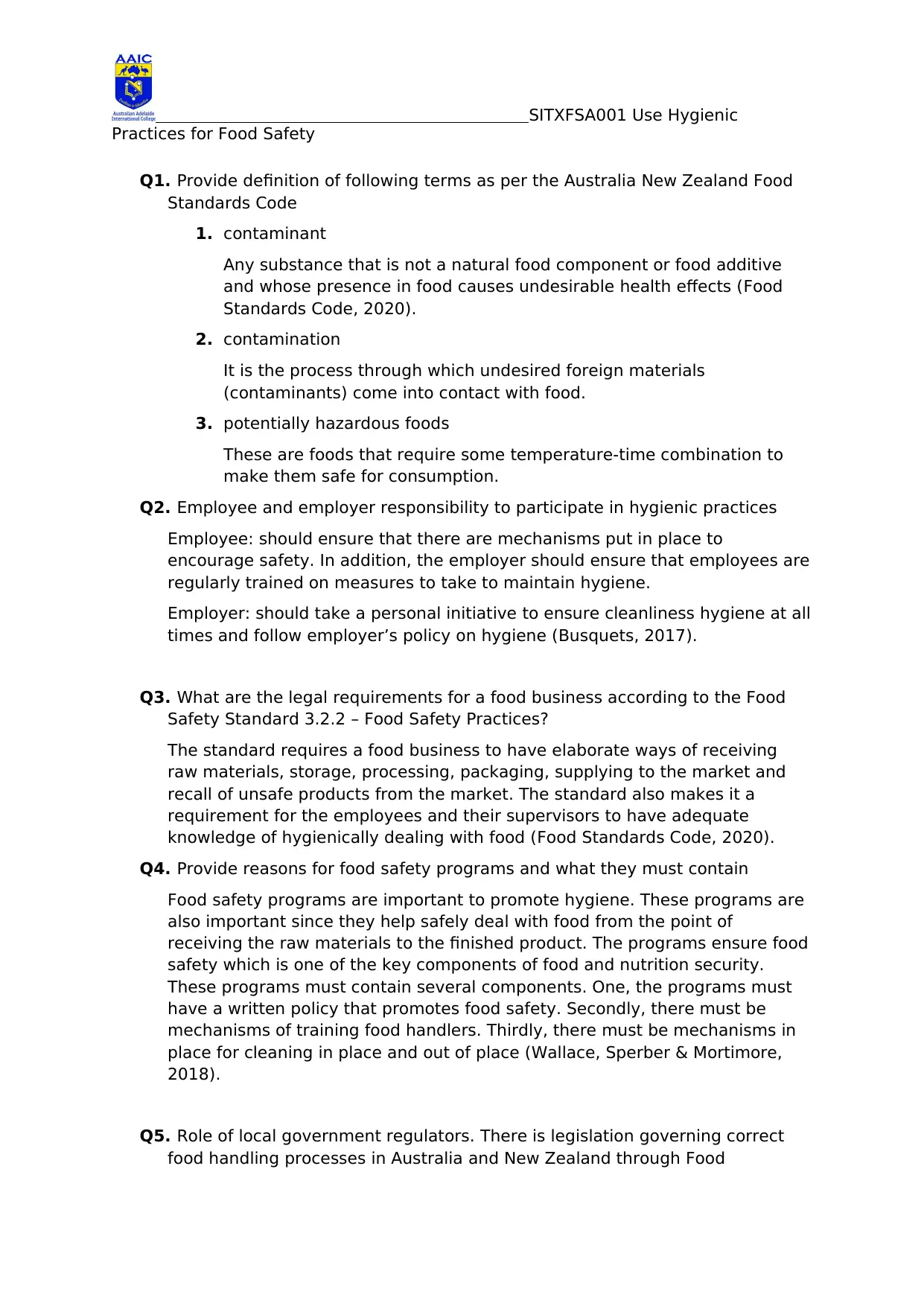
SITXFSA001 Use Hygienic
Practices for Food Safety
Q1. Provide definition of following terms as per the Australia New Zealand Food
Standards Code
1. contaminant
Any substance that is not a natural food component or food additive
and whose presence in food causes undesirable health effects (Food
Standards Code, 2020).
2. contamination
It is the process through which undesired foreign materials
(contaminants) come into contact with food.
3. potentially hazardous foods
These are foods that require some temperature-time combination to
make them safe for consumption.
Q2. Employee and employer responsibility to participate in hygienic practices
Employee: should ensure that there are mechanisms put in place to
encourage safety. In addition, the employer should ensure that employees are
regularly trained on measures to take to maintain hygiene.
Employer: should take a personal initiative to ensure cleanliness hygiene at all
times and follow employer’s policy on hygiene (Busquets, 2017).
Q3. What are the legal requirements for a food business according to the Food
Safety Standard 3.2.2 – Food Safety Practices?
The standard requires a food business to have elaborate ways of receiving
raw materials, storage, processing, packaging, supplying to the market and
recall of unsafe products from the market. The standard also makes it a
requirement for the employees and their supervisors to have adequate
knowledge of hygienically dealing with food (Food Standards Code, 2020).
Q4. Provide reasons for food safety programs and what they must contain
Food safety programs are important to promote hygiene. These programs are
also important since they help safely deal with food from the point of
receiving the raw materials to the finished product. The programs ensure food
safety which is one of the key components of food and nutrition security.
These programs must contain several components. One, the programs must
have a written policy that promotes food safety. Secondly, there must be
mechanisms of training food handlers. Thirdly, there must be mechanisms in
place for cleaning in place and out of place (Wallace, Sperber & Mortimore,
2018).
Q5. Role of local government regulators. There is legislation governing correct
food handling processes in Australia and New Zealand through Food
Practices for Food Safety
Q1. Provide definition of following terms as per the Australia New Zealand Food
Standards Code
1. contaminant
Any substance that is not a natural food component or food additive
and whose presence in food causes undesirable health effects (Food
Standards Code, 2020).
2. contamination
It is the process through which undesired foreign materials
(contaminants) come into contact with food.
3. potentially hazardous foods
These are foods that require some temperature-time combination to
make them safe for consumption.
Q2. Employee and employer responsibility to participate in hygienic practices
Employee: should ensure that there are mechanisms put in place to
encourage safety. In addition, the employer should ensure that employees are
regularly trained on measures to take to maintain hygiene.
Employer: should take a personal initiative to ensure cleanliness hygiene at all
times and follow employer’s policy on hygiene (Busquets, 2017).
Q3. What are the legal requirements for a food business according to the Food
Safety Standard 3.2.2 – Food Safety Practices?
The standard requires a food business to have elaborate ways of receiving
raw materials, storage, processing, packaging, supplying to the market and
recall of unsafe products from the market. The standard also makes it a
requirement for the employees and their supervisors to have adequate
knowledge of hygienically dealing with food (Food Standards Code, 2020).
Q4. Provide reasons for food safety programs and what they must contain
Food safety programs are important to promote hygiene. These programs are
also important since they help safely deal with food from the point of
receiving the raw materials to the finished product. The programs ensure food
safety which is one of the key components of food and nutrition security.
These programs must contain several components. One, the programs must
have a written policy that promotes food safety. Secondly, there must be
mechanisms of training food handlers. Thirdly, there must be mechanisms in
place for cleaning in place and out of place (Wallace, Sperber & Mortimore,
2018).
Q5. Role of local government regulators. There is legislation governing correct
food handling processes in Australia and New Zealand through Food
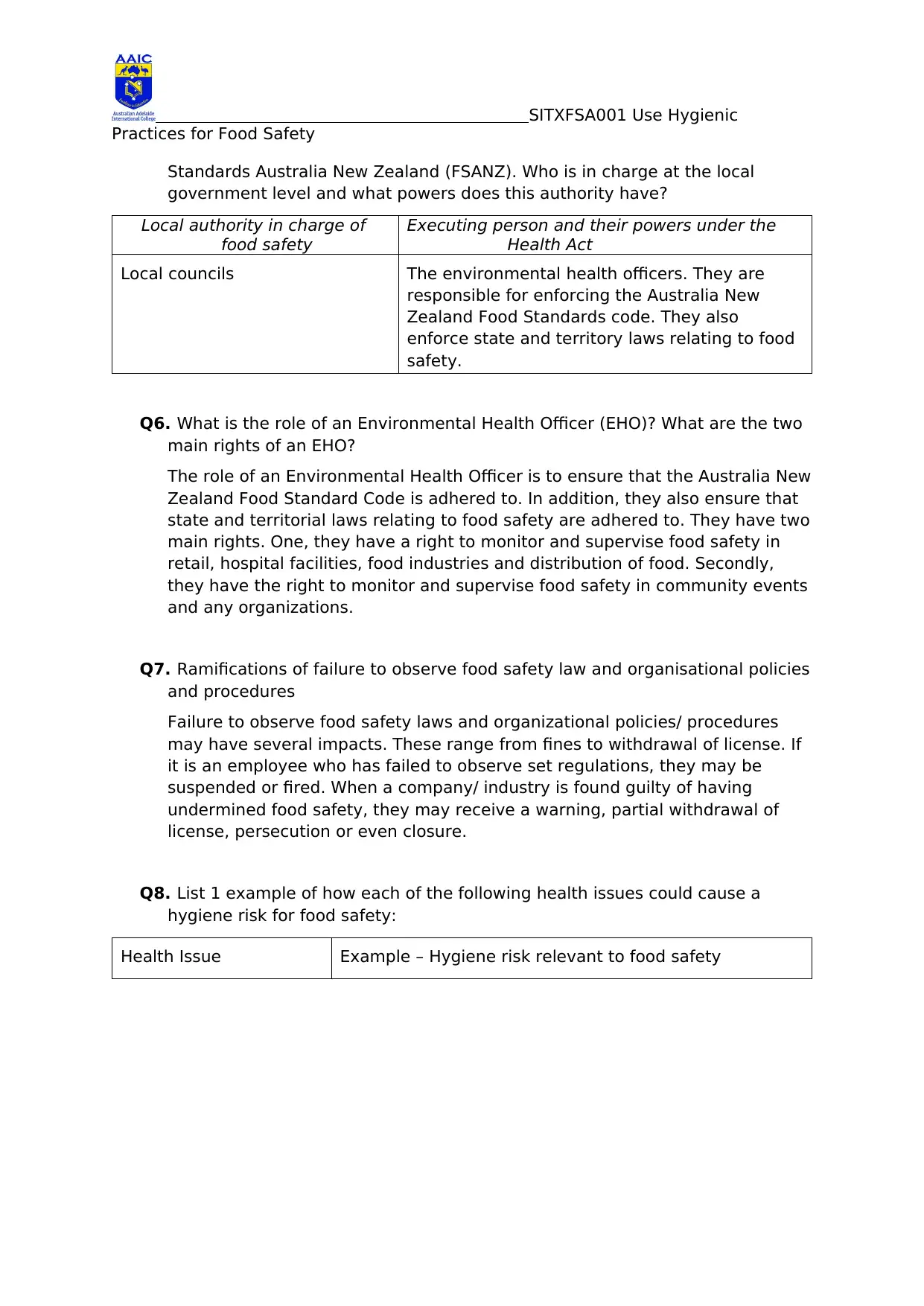
SITXFSA001 Use Hygienic
Practices for Food Safety
Standards Australia New Zealand (FSANZ). Who is in charge at the local
government level and what powers does this authority have?
Local authority in charge of
food safety
Executing person and their powers under the
Health Act
Local councils The environmental health officers. They are
responsible for enforcing the Australia New
Zealand Food Standards code. They also
enforce state and territory laws relating to food
safety.
Q6. What is the role of an Environmental Health Officer (EHO)? What are the two
main rights of an EHO?
The role of an Environmental Health Officer is to ensure that the Australia New
Zealand Food Standard Code is adhered to. In addition, they also ensure that
state and territorial laws relating to food safety are adhered to. They have two
main rights. One, they have a right to monitor and supervise food safety in
retail, hospital facilities, food industries and distribution of food. Secondly,
they have the right to monitor and supervise food safety in community events
and any organizations.
Q7. Ramifications of failure to observe food safety law and organisational policies
and procedures
Failure to observe food safety laws and organizational policies/ procedures
may have several impacts. These range from fines to withdrawal of license. If
it is an employee who has failed to observe set regulations, they may be
suspended or fired. When a company/ industry is found guilty of having
undermined food safety, they may receive a warning, partial withdrawal of
license, persecution or even closure.
Q8. List 1 example of how each of the following health issues could cause a
hygiene risk for food safety:
Health Issue Example – Hygiene risk relevant to food safety
Practices for Food Safety
Standards Australia New Zealand (FSANZ). Who is in charge at the local
government level and what powers does this authority have?
Local authority in charge of
food safety
Executing person and their powers under the
Health Act
Local councils The environmental health officers. They are
responsible for enforcing the Australia New
Zealand Food Standards code. They also
enforce state and territory laws relating to food
safety.
Q6. What is the role of an Environmental Health Officer (EHO)? What are the two
main rights of an EHO?
The role of an Environmental Health Officer is to ensure that the Australia New
Zealand Food Standard Code is adhered to. In addition, they also ensure that
state and territorial laws relating to food safety are adhered to. They have two
main rights. One, they have a right to monitor and supervise food safety in
retail, hospital facilities, food industries and distribution of food. Secondly,
they have the right to monitor and supervise food safety in community events
and any organizations.
Q7. Ramifications of failure to observe food safety law and organisational policies
and procedures
Failure to observe food safety laws and organizational policies/ procedures
may have several impacts. These range from fines to withdrawal of license. If
it is an employee who has failed to observe set regulations, they may be
suspended or fired. When a company/ industry is found guilty of having
undermined food safety, they may receive a warning, partial withdrawal of
license, persecution or even closure.
Q8. List 1 example of how each of the following health issues could cause a
hygiene risk for food safety:
Health Issue Example – Hygiene risk relevant to food safety
⊘ This is a preview!⊘
Do you want full access?
Subscribe today to unlock all pages.

Trusted by 1+ million students worldwide
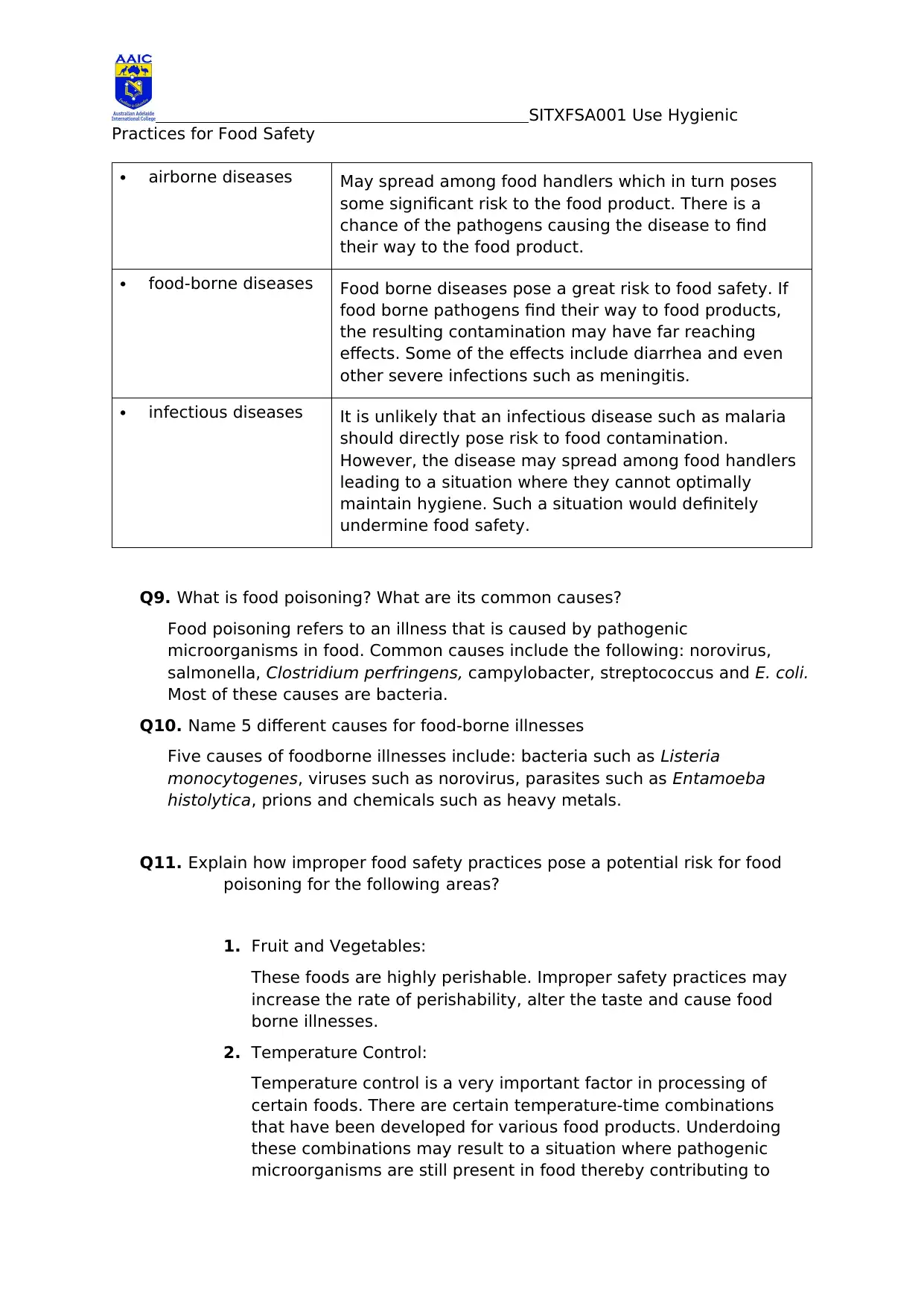
SITXFSA001 Use Hygienic
Practices for Food Safety
airborne diseases May spread among food handlers which in turn poses
some significant risk to the food product. There is a
chance of the pathogens causing the disease to find
their way to the food product.
food-borne diseases Food borne diseases pose a great risk to food safety. If
food borne pathogens find their way to food products,
the resulting contamination may have far reaching
effects. Some of the effects include diarrhea and even
other severe infections such as meningitis.
infectious diseases It is unlikely that an infectious disease such as malaria
should directly pose risk to food contamination.
However, the disease may spread among food handlers
leading to a situation where they cannot optimally
maintain hygiene. Such a situation would definitely
undermine food safety.
Q9. What is food poisoning? What are its common causes?
Food poisoning refers to an illness that is caused by pathogenic
microorganisms in food. Common causes include the following: norovirus,
salmonella, Clostridium perfringens, campylobacter, streptococcus and E. coli.
Most of these causes are bacteria.
Q10. Name 5 different causes for food-borne illnesses
Five causes of foodborne illnesses include: bacteria such as Listeria
monocytogenes, viruses such as norovirus, parasites such as Entamoeba
histolytica, prions and chemicals such as heavy metals.
Q11. Explain how improper food safety practices pose a potential risk for food
poisoning for the following areas?
1. Fruit and Vegetables:
These foods are highly perishable. Improper safety practices may
increase the rate of perishability, alter the taste and cause food
borne illnesses.
2. Temperature Control:
Temperature control is a very important factor in processing of
certain foods. There are certain temperature-time combinations
that have been developed for various food products. Underdoing
these combinations may result to a situation where pathogenic
microorganisms are still present in food thereby contributing to
Practices for Food Safety
airborne diseases May spread among food handlers which in turn poses
some significant risk to the food product. There is a
chance of the pathogens causing the disease to find
their way to the food product.
food-borne diseases Food borne diseases pose a great risk to food safety. If
food borne pathogens find their way to food products,
the resulting contamination may have far reaching
effects. Some of the effects include diarrhea and even
other severe infections such as meningitis.
infectious diseases It is unlikely that an infectious disease such as malaria
should directly pose risk to food contamination.
However, the disease may spread among food handlers
leading to a situation where they cannot optimally
maintain hygiene. Such a situation would definitely
undermine food safety.
Q9. What is food poisoning? What are its common causes?
Food poisoning refers to an illness that is caused by pathogenic
microorganisms in food. Common causes include the following: norovirus,
salmonella, Clostridium perfringens, campylobacter, streptococcus and E. coli.
Most of these causes are bacteria.
Q10. Name 5 different causes for food-borne illnesses
Five causes of foodborne illnesses include: bacteria such as Listeria
monocytogenes, viruses such as norovirus, parasites such as Entamoeba
histolytica, prions and chemicals such as heavy metals.
Q11. Explain how improper food safety practices pose a potential risk for food
poisoning for the following areas?
1. Fruit and Vegetables:
These foods are highly perishable. Improper safety practices may
increase the rate of perishability, alter the taste and cause food
borne illnesses.
2. Temperature Control:
Temperature control is a very important factor in processing of
certain foods. There are certain temperature-time combinations
that have been developed for various food products. Underdoing
these combinations may result to a situation where pathogenic
microorganisms are still present in food thereby contributing to
Paraphrase This Document
Need a fresh take? Get an instant paraphrase of this document with our AI Paraphraser
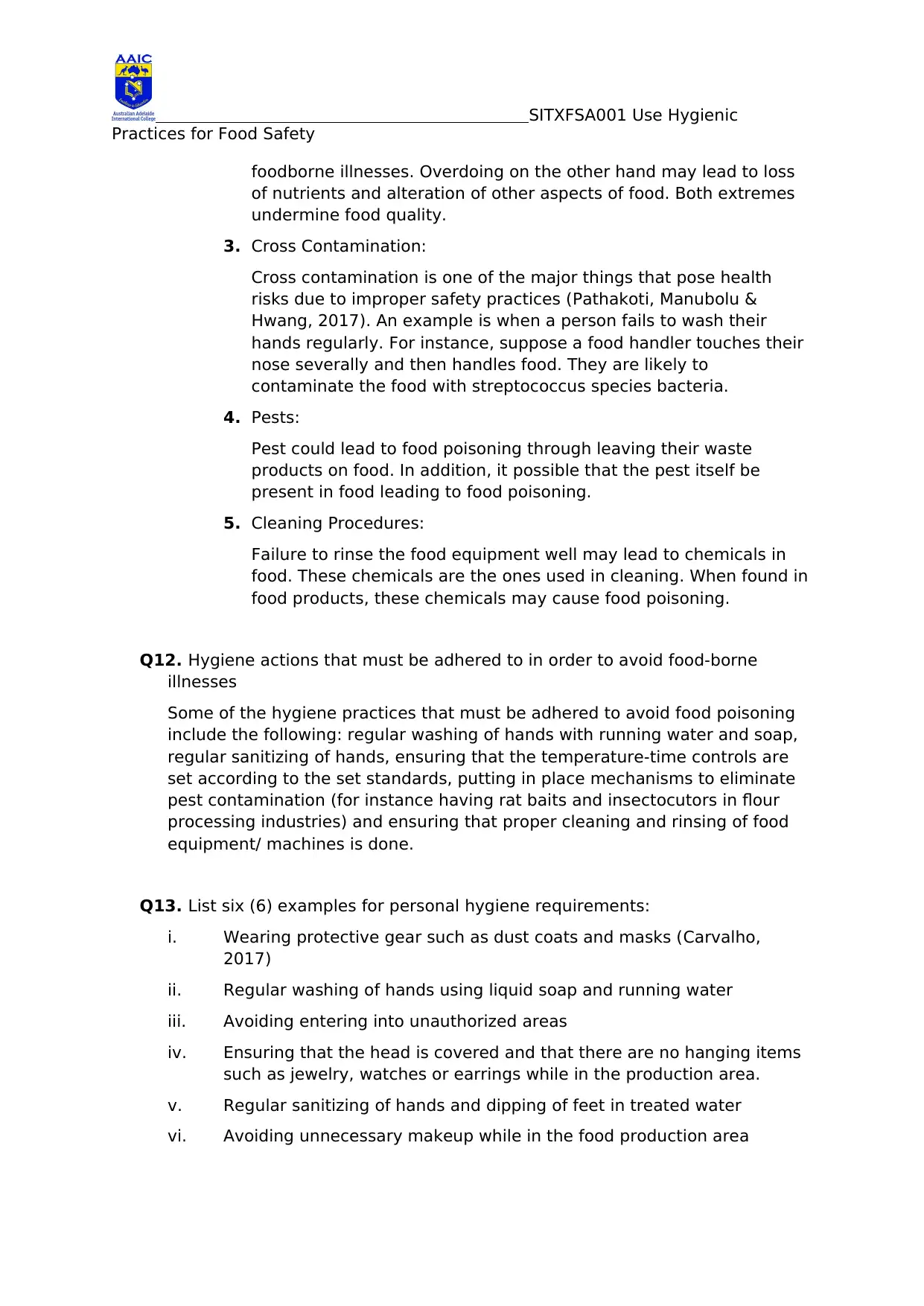
SITXFSA001 Use Hygienic
Practices for Food Safety
foodborne illnesses. Overdoing on the other hand may lead to loss
of nutrients and alteration of other aspects of food. Both extremes
undermine food quality.
3. Cross Contamination:
Cross contamination is one of the major things that pose health
risks due to improper safety practices (Pathakoti, Manubolu &
Hwang, 2017). An example is when a person fails to wash their
hands regularly. For instance, suppose a food handler touches their
nose severally and then handles food. They are likely to
contaminate the food with streptococcus species bacteria.
4. Pests:
Pest could lead to food poisoning through leaving their waste
products on food. In addition, it possible that the pest itself be
present in food leading to food poisoning.
5. Cleaning Procedures:
Failure to rinse the food equipment well may lead to chemicals in
food. These chemicals are the ones used in cleaning. When found in
food products, these chemicals may cause food poisoning.
Q12. Hygiene actions that must be adhered to in order to avoid food-borne
illnesses
Some of the hygiene practices that must be adhered to avoid food poisoning
include the following: regular washing of hands with running water and soap,
regular sanitizing of hands, ensuring that the temperature-time controls are
set according to the set standards, putting in place mechanisms to eliminate
pest contamination (for instance having rat baits and insectocutors in flour
processing industries) and ensuring that proper cleaning and rinsing of food
equipment/ machines is done.
Q13. List six (6) examples for personal hygiene requirements:
i. Wearing protective gear such as dust coats and masks (Carvalho,
2017)
ii. Regular washing of hands using liquid soap and running water
iii. Avoiding entering into unauthorized areas
iv. Ensuring that the head is covered and that there are no hanging items
such as jewelry, watches or earrings while in the production area.
v. Regular sanitizing of hands and dipping of feet in treated water
vi. Avoiding unnecessary makeup while in the food production area
Practices for Food Safety
foodborne illnesses. Overdoing on the other hand may lead to loss
of nutrients and alteration of other aspects of food. Both extremes
undermine food quality.
3. Cross Contamination:
Cross contamination is one of the major things that pose health
risks due to improper safety practices (Pathakoti, Manubolu &
Hwang, 2017). An example is when a person fails to wash their
hands regularly. For instance, suppose a food handler touches their
nose severally and then handles food. They are likely to
contaminate the food with streptococcus species bacteria.
4. Pests:
Pest could lead to food poisoning through leaving their waste
products on food. In addition, it possible that the pest itself be
present in food leading to food poisoning.
5. Cleaning Procedures:
Failure to rinse the food equipment well may lead to chemicals in
food. These chemicals are the ones used in cleaning. When found in
food products, these chemicals may cause food poisoning.
Q12. Hygiene actions that must be adhered to in order to avoid food-borne
illnesses
Some of the hygiene practices that must be adhered to avoid food poisoning
include the following: regular washing of hands with running water and soap,
regular sanitizing of hands, ensuring that the temperature-time controls are
set according to the set standards, putting in place mechanisms to eliminate
pest contamination (for instance having rat baits and insectocutors in flour
processing industries) and ensuring that proper cleaning and rinsing of food
equipment/ machines is done.
Q13. List six (6) examples for personal hygiene requirements:
i. Wearing protective gear such as dust coats and masks (Carvalho,
2017)
ii. Regular washing of hands using liquid soap and running water
iii. Avoiding entering into unauthorized areas
iv. Ensuring that the head is covered and that there are no hanging items
such as jewelry, watches or earrings while in the production area.
v. Regular sanitizing of hands and dipping of feet in treated water
vi. Avoiding unnecessary makeup while in the food production area
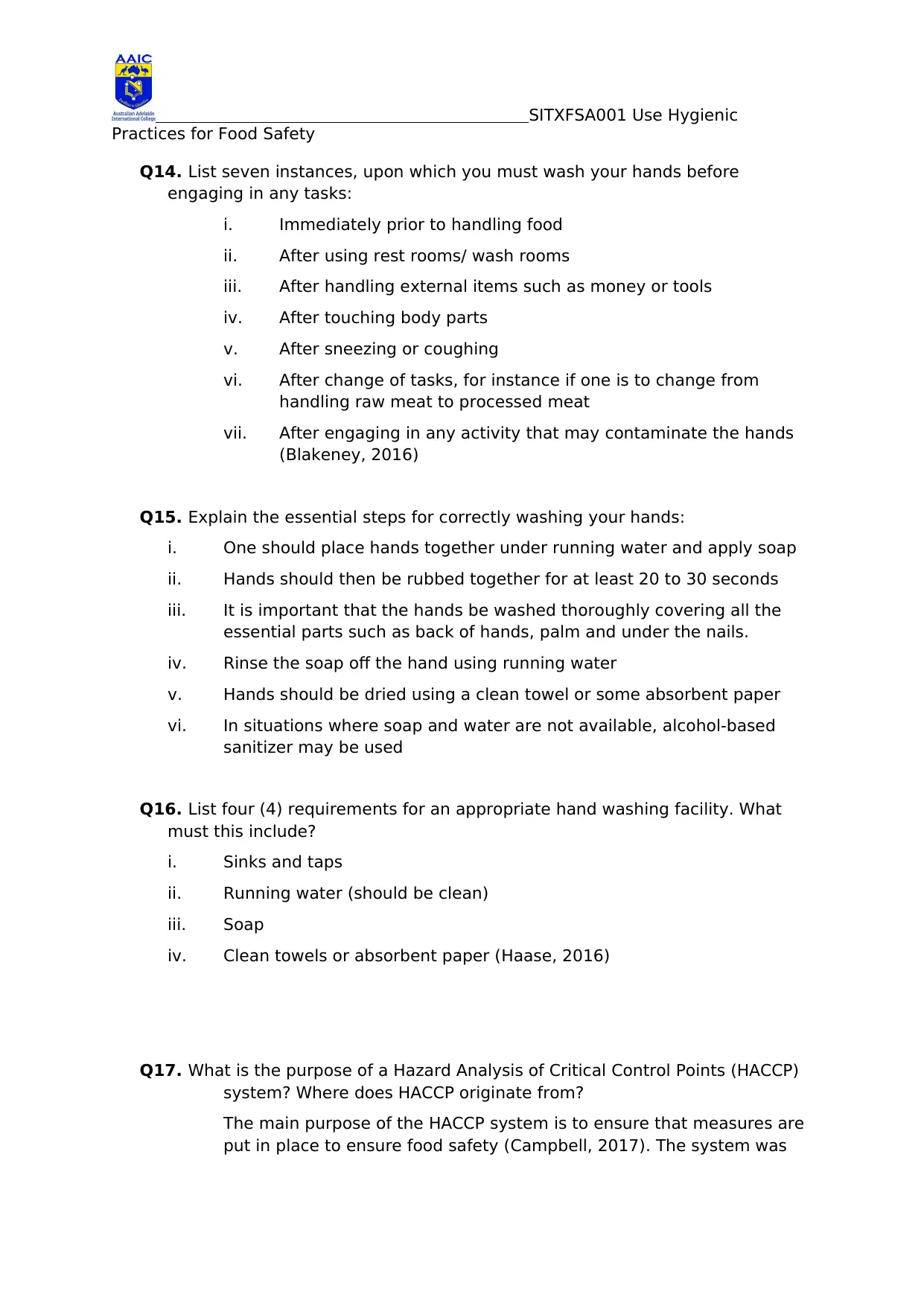
SITXFSA001 Use Hygienic
Practices for Food Safety
Q14. List seven instances, upon which you must wash your hands before
engaging in any tasks:
i. Immediately prior to handling food
ii. After using rest rooms/ wash rooms
iii. After handling external items such as money or tools
iv. After touching body parts
v. After sneezing or coughing
vi. After change of tasks, for instance if one is to change from
handling raw meat to processed meat
vii. After engaging in any activity that may contaminate the hands
(Blakeney, 2016)
Q15. Explain the essential steps for correctly washing your hands:
i. One should place hands together under running water and apply soap
ii. Hands should then be rubbed together for at least 20 to 30 seconds
iii. It is important that the hands be washed thoroughly covering all the
essential parts such as back of hands, palm and under the nails.
iv. Rinse the soap off the hand using running water
v. Hands should be dried using a clean towel or some absorbent paper
vi. In situations where soap and water are not available, alcohol-based
sanitizer may be used
Q16. List four (4) requirements for an appropriate hand washing facility. What
must this include?
i. Sinks and taps
ii. Running water (should be clean)
iii. Soap
iv. Clean towels or absorbent paper (Haase, 2016)
Q17. What is the purpose of a Hazard Analysis of Critical Control Points (HACCP)
system? Where does HACCP originate from?
The main purpose of the HACCP system is to ensure that measures are
put in place to ensure food safety (Campbell, 2017). The system was
Practices for Food Safety
Q14. List seven instances, upon which you must wash your hands before
engaging in any tasks:
i. Immediately prior to handling food
ii. After using rest rooms/ wash rooms
iii. After handling external items such as money or tools
iv. After touching body parts
v. After sneezing or coughing
vi. After change of tasks, for instance if one is to change from
handling raw meat to processed meat
vii. After engaging in any activity that may contaminate the hands
(Blakeney, 2016)
Q15. Explain the essential steps for correctly washing your hands:
i. One should place hands together under running water and apply soap
ii. Hands should then be rubbed together for at least 20 to 30 seconds
iii. It is important that the hands be washed thoroughly covering all the
essential parts such as back of hands, palm and under the nails.
iv. Rinse the soap off the hand using running water
v. Hands should be dried using a clean towel or some absorbent paper
vi. In situations where soap and water are not available, alcohol-based
sanitizer may be used
Q16. List four (4) requirements for an appropriate hand washing facility. What
must this include?
i. Sinks and taps
ii. Running water (should be clean)
iii. Soap
iv. Clean towels or absorbent paper (Haase, 2016)
Q17. What is the purpose of a Hazard Analysis of Critical Control Points (HACCP)
system? Where does HACCP originate from?
The main purpose of the HACCP system is to ensure that measures are
put in place to ensure food safety (Campbell, 2017). The system was
⊘ This is a preview!⊘
Do you want full access?
Subscribe today to unlock all pages.

Trusted by 1+ million students worldwide
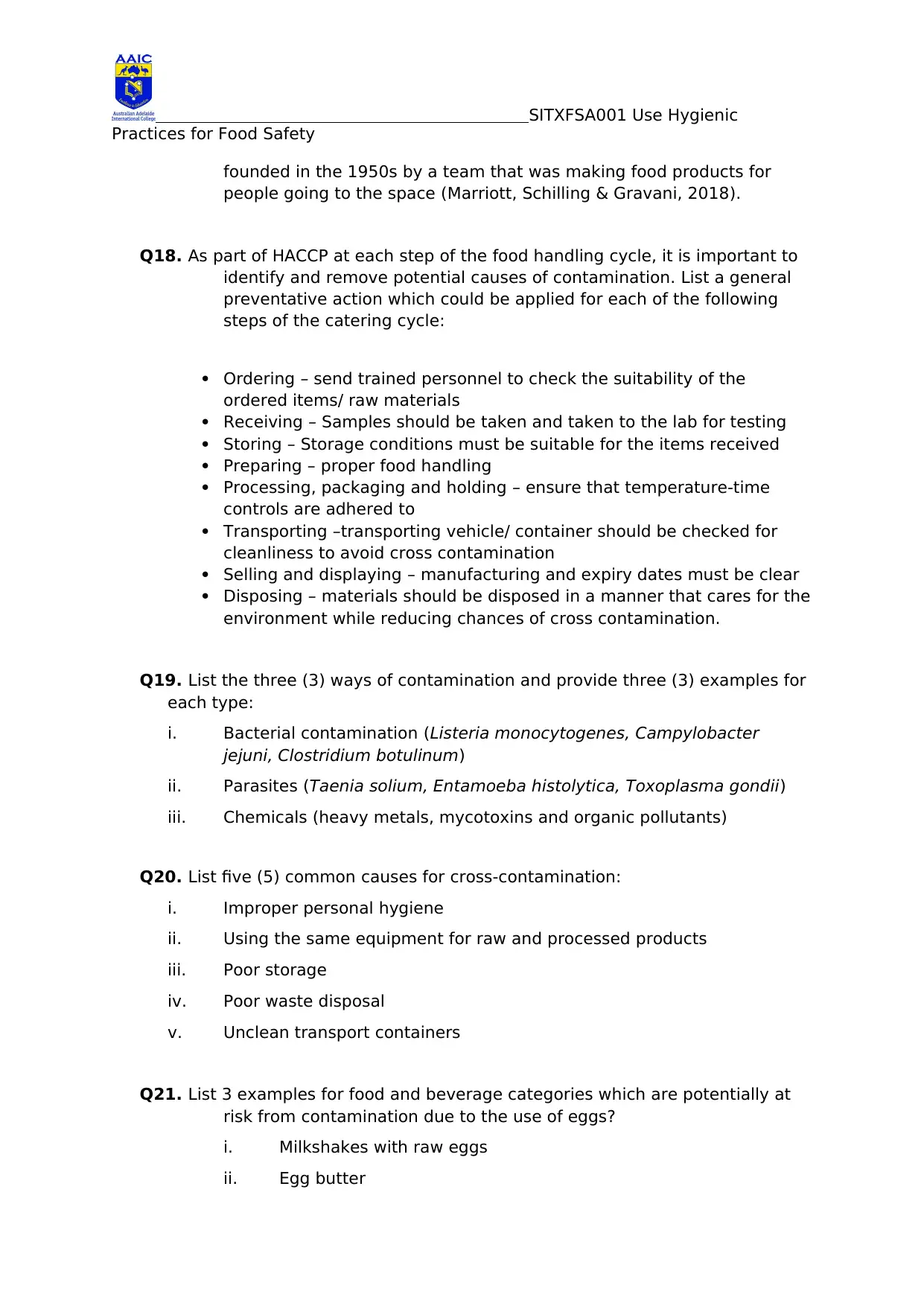
SITXFSA001 Use Hygienic
Practices for Food Safety
founded in the 1950s by a team that was making food products for
people going to the space (Marriott, Schilling & Gravani, 2018).
Q18. As part of HACCP at each step of the food handling cycle, it is important to
identify and remove potential causes of contamination. List a general
preventative action which could be applied for each of the following
steps of the catering cycle:
Ordering – send trained personnel to check the suitability of the
ordered items/ raw materials
Receiving – Samples should be taken and taken to the lab for testing
Storing – Storage conditions must be suitable for the items received
Preparing – proper food handling
Processing, packaging and holding – ensure that temperature-time
controls are adhered to
Transporting –transporting vehicle/ container should be checked for
cleanliness to avoid cross contamination
Selling and displaying – manufacturing and expiry dates must be clear
Disposing – materials should be disposed in a manner that cares for the
environment while reducing chances of cross contamination.
Q19. List the three (3) ways of contamination and provide three (3) examples for
each type:
i. Bacterial contamination (Listeria monocytogenes, Campylobacter
jejuni, Clostridium botulinum)
ii. Parasites (Taenia solium, Entamoeba histolytica, Toxoplasma gondii)
iii. Chemicals (heavy metals, mycotoxins and organic pollutants)
Q20. List five (5) common causes for cross-contamination:
i. Improper personal hygiene
ii. Using the same equipment for raw and processed products
iii. Poor storage
iv. Poor waste disposal
v. Unclean transport containers
Q21. List 3 examples for food and beverage categories which are potentially at
risk from contamination due to the use of eggs?
i. Milkshakes with raw eggs
ii. Egg butter
Practices for Food Safety
founded in the 1950s by a team that was making food products for
people going to the space (Marriott, Schilling & Gravani, 2018).
Q18. As part of HACCP at each step of the food handling cycle, it is important to
identify and remove potential causes of contamination. List a general
preventative action which could be applied for each of the following
steps of the catering cycle:
Ordering – send trained personnel to check the suitability of the
ordered items/ raw materials
Receiving – Samples should be taken and taken to the lab for testing
Storing – Storage conditions must be suitable for the items received
Preparing – proper food handling
Processing, packaging and holding – ensure that temperature-time
controls are adhered to
Transporting –transporting vehicle/ container should be checked for
cleanliness to avoid cross contamination
Selling and displaying – manufacturing and expiry dates must be clear
Disposing – materials should be disposed in a manner that cares for the
environment while reducing chances of cross contamination.
Q19. List the three (3) ways of contamination and provide three (3) examples for
each type:
i. Bacterial contamination (Listeria monocytogenes, Campylobacter
jejuni, Clostridium botulinum)
ii. Parasites (Taenia solium, Entamoeba histolytica, Toxoplasma gondii)
iii. Chemicals (heavy metals, mycotoxins and organic pollutants)
Q20. List five (5) common causes for cross-contamination:
i. Improper personal hygiene
ii. Using the same equipment for raw and processed products
iii. Poor storage
iv. Poor waste disposal
v. Unclean transport containers
Q21. List 3 examples for food and beverage categories which are potentially at
risk from contamination due to the use of eggs?
i. Milkshakes with raw eggs
ii. Egg butter
Paraphrase This Document
Need a fresh take? Get an instant paraphrase of this document with our AI Paraphraser
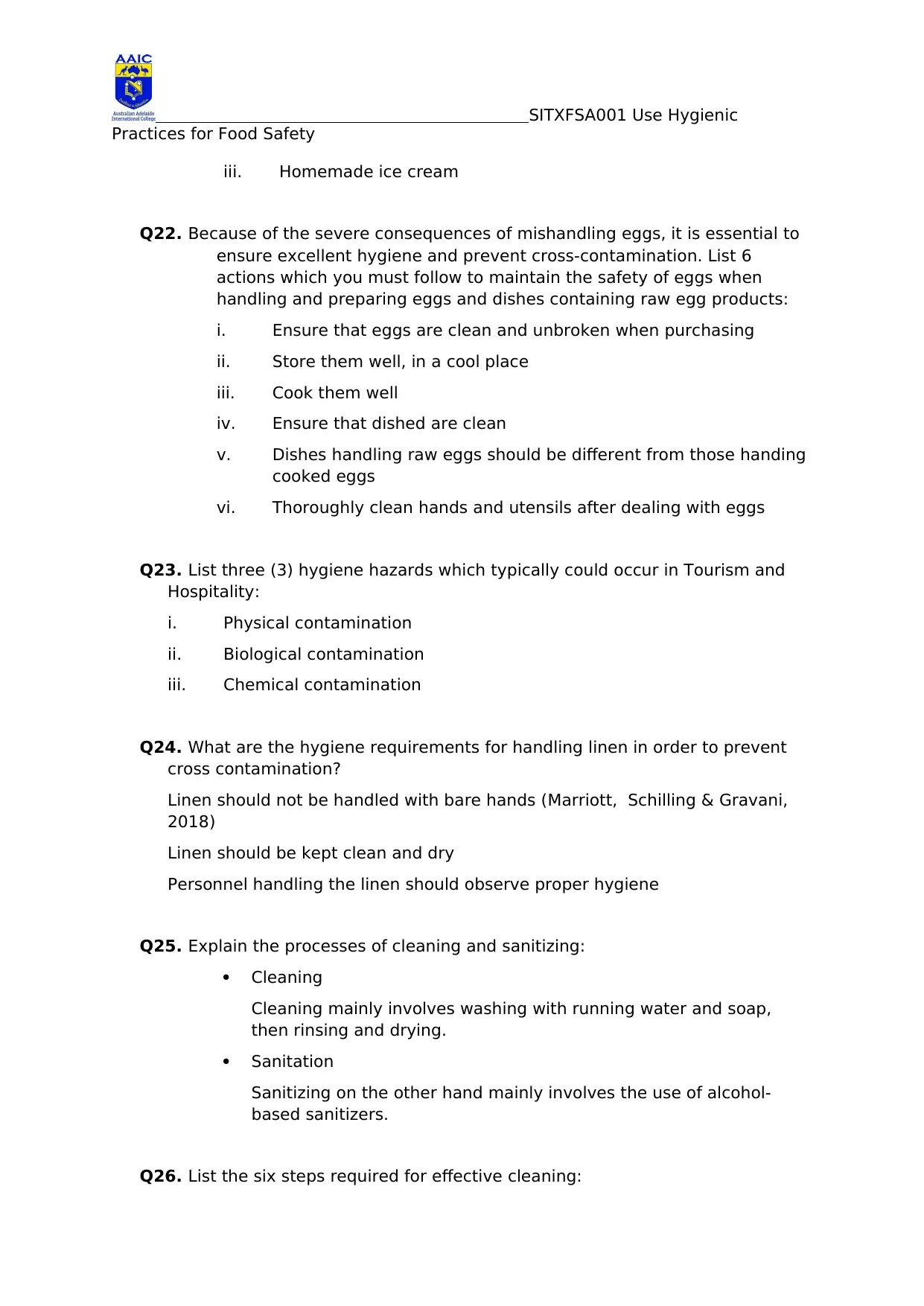
SITXFSA001 Use Hygienic
Practices for Food Safety
iii. Homemade ice cream
Q22. Because of the severe consequences of mishandling eggs, it is essential to
ensure excellent hygiene and prevent cross-contamination. List 6
actions which you must follow to maintain the safety of eggs when
handling and preparing eggs and dishes containing raw egg products:
i. Ensure that eggs are clean and unbroken when purchasing
ii. Store them well, in a cool place
iii. Cook them well
iv. Ensure that dished are clean
v. Dishes handling raw eggs should be different from those handing
cooked eggs
vi. Thoroughly clean hands and utensils after dealing with eggs
Q23. List three (3) hygiene hazards which typically could occur in Tourism and
Hospitality:
i. Physical contamination
ii. Biological contamination
iii. Chemical contamination
Q24. What are the hygiene requirements for handling linen in order to prevent
cross contamination?
Linen should not be handled with bare hands (Marriott, Schilling & Gravani,
2018)
Linen should be kept clean and dry
Personnel handling the linen should observe proper hygiene
Q25. Explain the processes of cleaning and sanitizing:
Cleaning
Cleaning mainly involves washing with running water and soap,
then rinsing and drying.
Sanitation
Sanitizing on the other hand mainly involves the use of alcohol-
based sanitizers.
Q26. List the six steps required for effective cleaning:
Practices for Food Safety
iii. Homemade ice cream
Q22. Because of the severe consequences of mishandling eggs, it is essential to
ensure excellent hygiene and prevent cross-contamination. List 6
actions which you must follow to maintain the safety of eggs when
handling and preparing eggs and dishes containing raw egg products:
i. Ensure that eggs are clean and unbroken when purchasing
ii. Store them well, in a cool place
iii. Cook them well
iv. Ensure that dished are clean
v. Dishes handling raw eggs should be different from those handing
cooked eggs
vi. Thoroughly clean hands and utensils after dealing with eggs
Q23. List three (3) hygiene hazards which typically could occur in Tourism and
Hospitality:
i. Physical contamination
ii. Biological contamination
iii. Chemical contamination
Q24. What are the hygiene requirements for handling linen in order to prevent
cross contamination?
Linen should not be handled with bare hands (Marriott, Schilling & Gravani,
2018)
Linen should be kept clean and dry
Personnel handling the linen should observe proper hygiene
Q25. Explain the processes of cleaning and sanitizing:
Cleaning
Cleaning mainly involves washing with running water and soap,
then rinsing and drying.
Sanitation
Sanitizing on the other hand mainly involves the use of alcohol-
based sanitizers.
Q26. List the six steps required for effective cleaning:
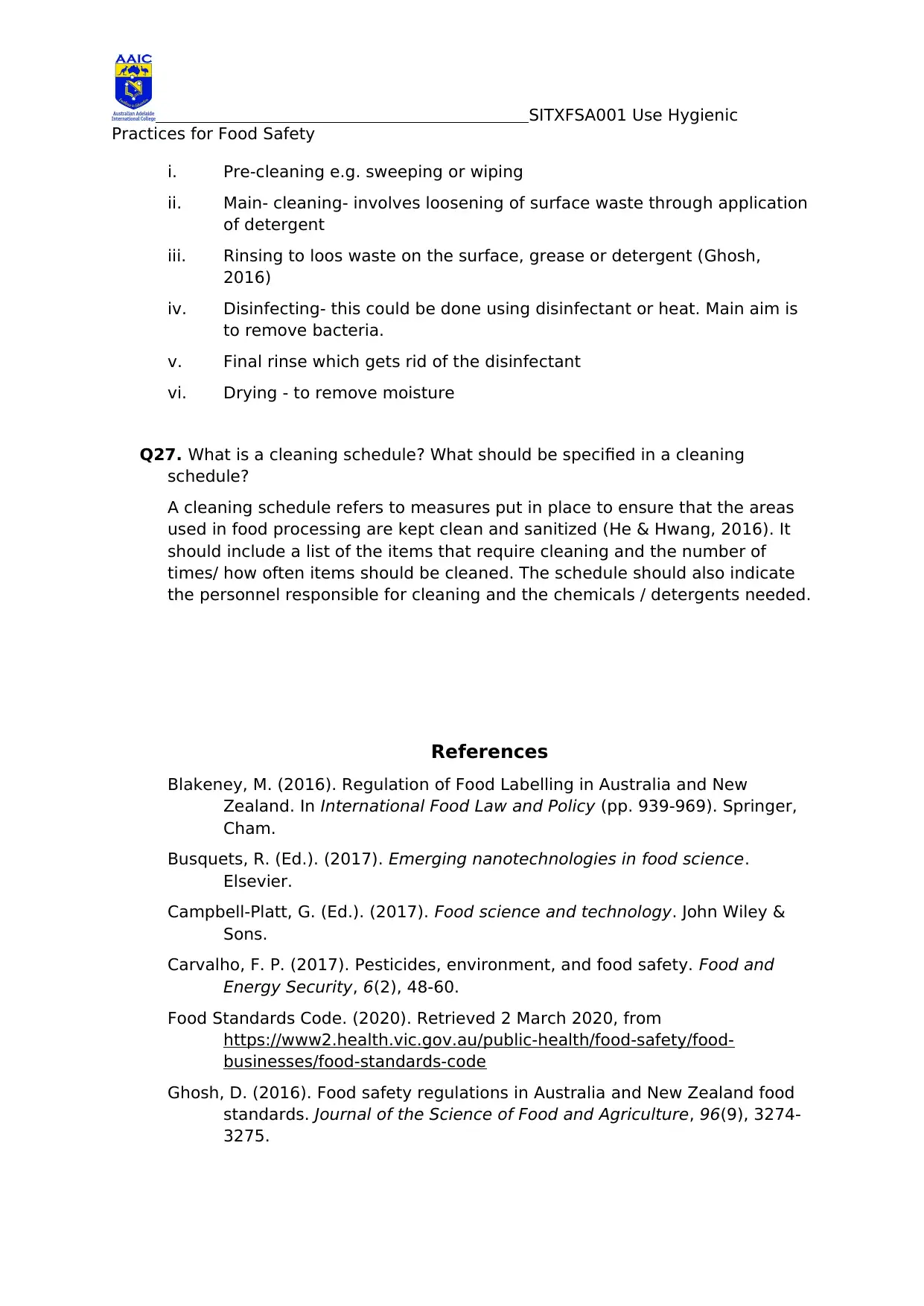
SITXFSA001 Use Hygienic
Practices for Food Safety
i. Pre-cleaning e.g. sweeping or wiping
ii. Main- cleaning- involves loosening of surface waste through application
of detergent
iii. Rinsing to loos waste on the surface, grease or detergent (Ghosh,
2016)
iv. Disinfecting- this could be done using disinfectant or heat. Main aim is
to remove bacteria.
v. Final rinse which gets rid of the disinfectant
vi. Drying - to remove moisture
Q27. What is a cleaning schedule? What should be specified in a cleaning
schedule?
A cleaning schedule refers to measures put in place to ensure that the areas
used in food processing are kept clean and sanitized (He & Hwang, 2016). It
should include a list of the items that require cleaning and the number of
times/ how often items should be cleaned. The schedule should also indicate
the personnel responsible for cleaning and the chemicals / detergents needed.
References
Blakeney, M. (2016). Regulation of Food Labelling in Australia and New
Zealand. In International Food Law and Policy (pp. 939-969). Springer,
Cham.
Busquets, R. (Ed.). (2017). Emerging nanotechnologies in food science.
Elsevier.
Campbell-Platt, G. (Ed.). (2017). Food science and technology. John Wiley &
Sons.
Carvalho, F. P. (2017). Pesticides, environment, and food safety. Food and
Energy Security, 6(2), 48-60.
Food Standards Code. (2020). Retrieved 2 March 2020, from
https://www2.health.vic.gov.au/public-health/food-safety/food-
businesses/food-standards-code
Ghosh, D. (2016). Food safety regulations in Australia and New Zealand food
standards. Journal of the Science of Food and Agriculture, 96(9), 3274-
3275.
Practices for Food Safety
i. Pre-cleaning e.g. sweeping or wiping
ii. Main- cleaning- involves loosening of surface waste through application
of detergent
iii. Rinsing to loos waste on the surface, grease or detergent (Ghosh,
2016)
iv. Disinfecting- this could be done using disinfectant or heat. Main aim is
to remove bacteria.
v. Final rinse which gets rid of the disinfectant
vi. Drying - to remove moisture
Q27. What is a cleaning schedule? What should be specified in a cleaning
schedule?
A cleaning schedule refers to measures put in place to ensure that the areas
used in food processing are kept clean and sanitized (He & Hwang, 2016). It
should include a list of the items that require cleaning and the number of
times/ how often items should be cleaned. The schedule should also indicate
the personnel responsible for cleaning and the chemicals / detergents needed.
References
Blakeney, M. (2016). Regulation of Food Labelling in Australia and New
Zealand. In International Food Law and Policy (pp. 939-969). Springer,
Cham.
Busquets, R. (Ed.). (2017). Emerging nanotechnologies in food science.
Elsevier.
Campbell-Platt, G. (Ed.). (2017). Food science and technology. John Wiley &
Sons.
Carvalho, F. P. (2017). Pesticides, environment, and food safety. Food and
Energy Security, 6(2), 48-60.
Food Standards Code. (2020). Retrieved 2 March 2020, from
https://www2.health.vic.gov.au/public-health/food-safety/food-
businesses/food-standards-code
Ghosh, D. (2016). Food safety regulations in Australia and New Zealand food
standards. Journal of the Science of Food and Agriculture, 96(9), 3274-
3275.
⊘ This is a preview!⊘
Do you want full access?
Subscribe today to unlock all pages.

Trusted by 1+ million students worldwide
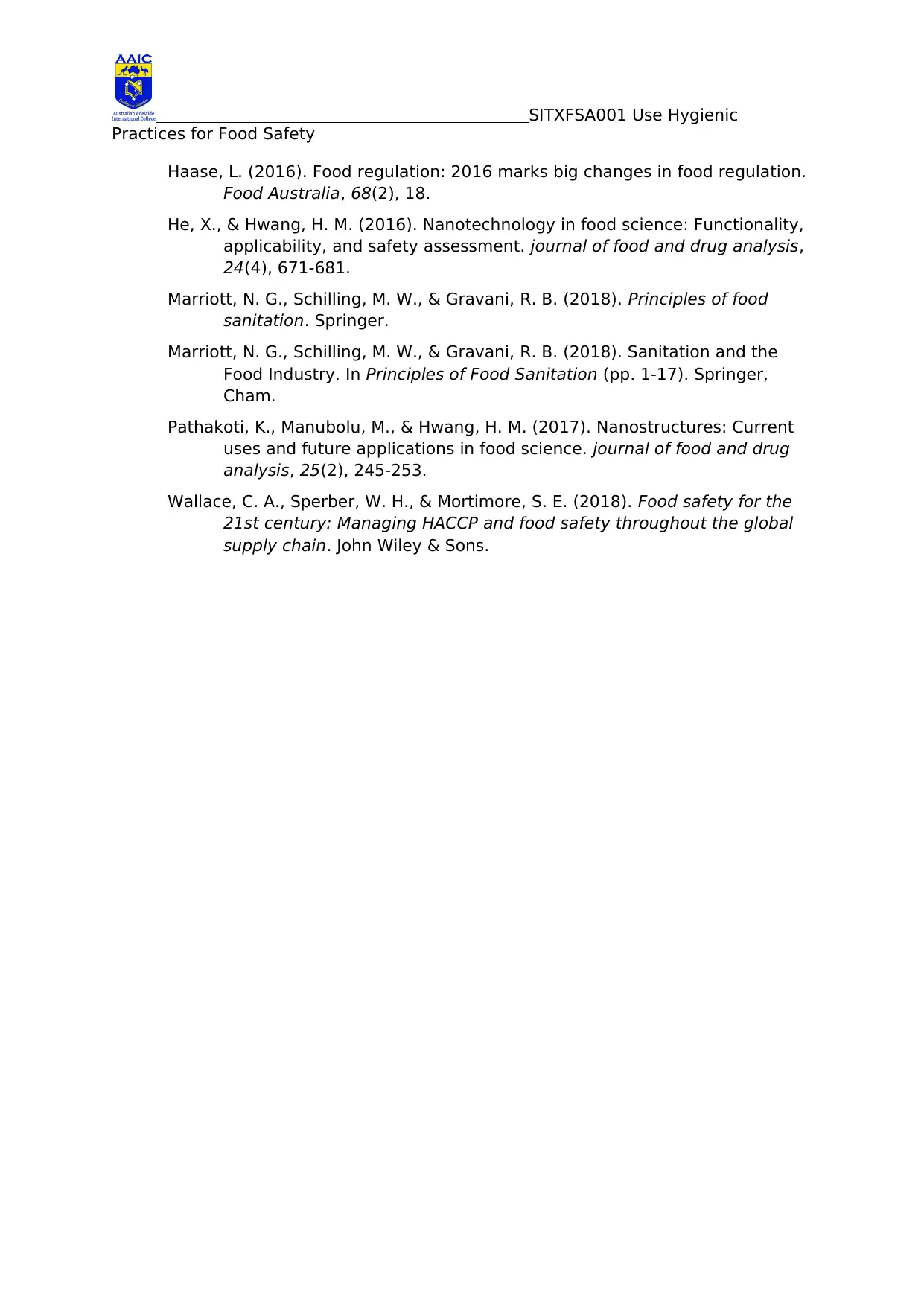
SITXFSA001 Use Hygienic
Practices for Food Safety
Haase, L. (2016). Food regulation: 2016 marks big changes in food regulation.
Food Australia, 68(2), 18.
He, X., & Hwang, H. M. (2016). Nanotechnology in food science: Functionality,
applicability, and safety assessment. journal of food and drug analysis,
24(4), 671-681.
Marriott, N. G., Schilling, M. W., & Gravani, R. B. (2018). Principles of food
sanitation. Springer.
Marriott, N. G., Schilling, M. W., & Gravani, R. B. (2018). Sanitation and the
Food Industry. In Principles of Food Sanitation (pp. 1-17). Springer,
Cham.
Pathakoti, K., Manubolu, M., & Hwang, H. M. (2017). Nanostructures: Current
uses and future applications in food science. journal of food and drug
analysis, 25(2), 245-253.
Wallace, C. A., Sperber, W. H., & Mortimore, S. E. (2018). Food safety for the
21st century: Managing HACCP and food safety throughout the global
supply chain. John Wiley & Sons.
Practices for Food Safety
Haase, L. (2016). Food regulation: 2016 marks big changes in food regulation.
Food Australia, 68(2), 18.
He, X., & Hwang, H. M. (2016). Nanotechnology in food science: Functionality,
applicability, and safety assessment. journal of food and drug analysis,
24(4), 671-681.
Marriott, N. G., Schilling, M. W., & Gravani, R. B. (2018). Principles of food
sanitation. Springer.
Marriott, N. G., Schilling, M. W., & Gravani, R. B. (2018). Sanitation and the
Food Industry. In Principles of Food Sanitation (pp. 1-17). Springer,
Cham.
Pathakoti, K., Manubolu, M., & Hwang, H. M. (2017). Nanostructures: Current
uses and future applications in food science. journal of food and drug
analysis, 25(2), 245-253.
Wallace, C. A., Sperber, W. H., & Mortimore, S. E. (2018). Food safety for the
21st century: Managing HACCP and food safety throughout the global
supply chain. John Wiley & Sons.
Paraphrase This Document
Need a fresh take? Get an instant paraphrase of this document with our AI Paraphraser
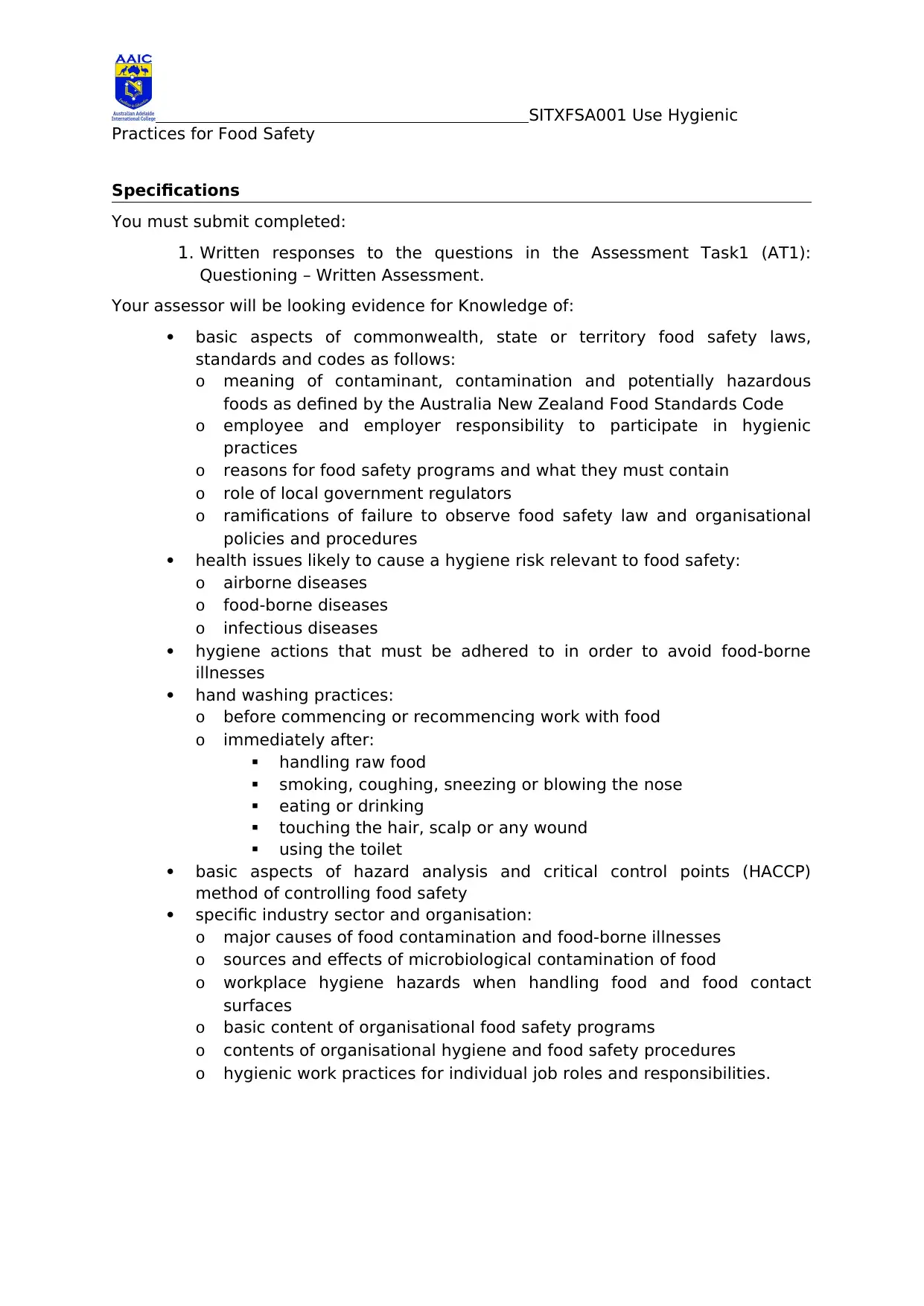
SITXFSA001 Use Hygienic
Practices for Food Safety
Specifications
You must submit completed:
1. Written responses to the questions in the Assessment Task1 (AT1):
Questioning – Written Assessment.
Your assessor will be looking evidence for Knowledge of:
basic aspects of commonwealth, state or territory food safety laws,
standards and codes as follows:
o meaning of contaminant, contamination and potentially hazardous
foods as defined by the Australia New Zealand Food Standards Code
o employee and employer responsibility to participate in hygienic
practices
o reasons for food safety programs and what they must contain
o role of local government regulators
o ramifications of failure to observe food safety law and organisational
policies and procedures
health issues likely to cause a hygiene risk relevant to food safety:
o airborne diseases
o food-borne diseases
o infectious diseases
hygiene actions that must be adhered to in order to avoid food-borne
illnesses
hand washing practices:
o before commencing or recommencing work with food
o immediately after:
handling raw food
smoking, coughing, sneezing or blowing the nose
eating or drinking
touching the hair, scalp or any wound
using the toilet
basic aspects of hazard analysis and critical control points (HACCP)
method of controlling food safety
specific industry sector and organisation:
o major causes of food contamination and food-borne illnesses
o sources and effects of microbiological contamination of food
o workplace hygiene hazards when handling food and food contact
surfaces
o basic content of organisational food safety programs
o contents of organisational hygiene and food safety procedures
o hygienic work practices for individual job roles and responsibilities.
Practices for Food Safety
Specifications
You must submit completed:
1. Written responses to the questions in the Assessment Task1 (AT1):
Questioning – Written Assessment.
Your assessor will be looking evidence for Knowledge of:
basic aspects of commonwealth, state or territory food safety laws,
standards and codes as follows:
o meaning of contaminant, contamination and potentially hazardous
foods as defined by the Australia New Zealand Food Standards Code
o employee and employer responsibility to participate in hygienic
practices
o reasons for food safety programs and what they must contain
o role of local government regulators
o ramifications of failure to observe food safety law and organisational
policies and procedures
health issues likely to cause a hygiene risk relevant to food safety:
o airborne diseases
o food-borne diseases
o infectious diseases
hygiene actions that must be adhered to in order to avoid food-borne
illnesses
hand washing practices:
o before commencing or recommencing work with food
o immediately after:
handling raw food
smoking, coughing, sneezing or blowing the nose
eating or drinking
touching the hair, scalp or any wound
using the toilet
basic aspects of hazard analysis and critical control points (HACCP)
method of controlling food safety
specific industry sector and organisation:
o major causes of food contamination and food-borne illnesses
o sources and effects of microbiological contamination of food
o workplace hygiene hazards when handling food and food contact
surfaces
o basic content of organisational food safety programs
o contents of organisational hygiene and food safety procedures
o hygienic work practices for individual job roles and responsibilities.
1 out of 11
Related Documents
Your All-in-One AI-Powered Toolkit for Academic Success.
+13062052269
info@desklib.com
Available 24*7 on WhatsApp / Email
![[object Object]](/_next/static/media/star-bottom.7253800d.svg)
Unlock your academic potential
Copyright © 2020–2025 A2Z Services. All Rights Reserved. Developed and managed by ZUCOL.





